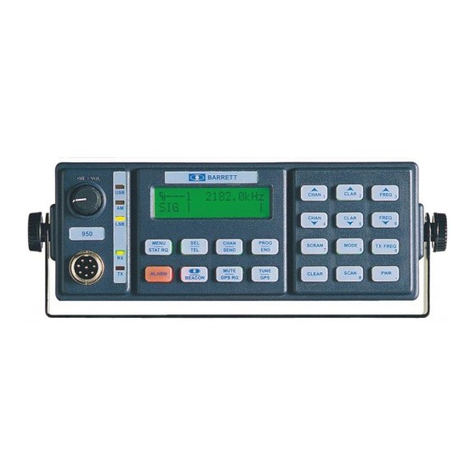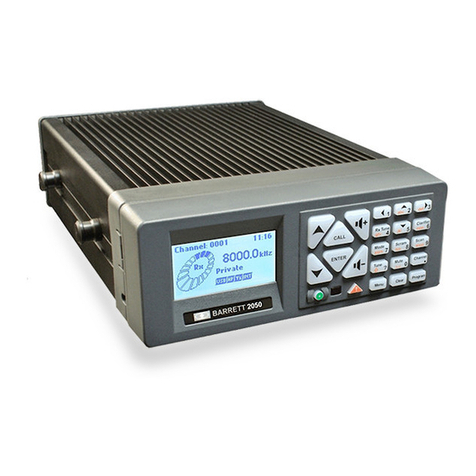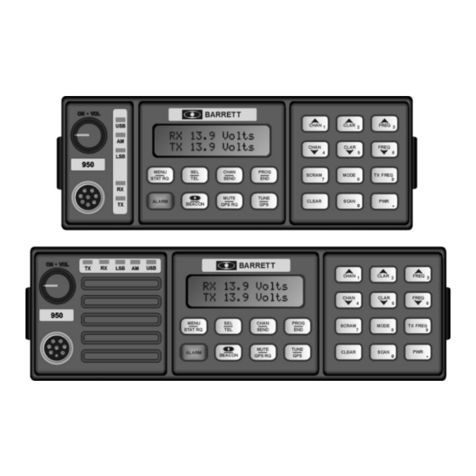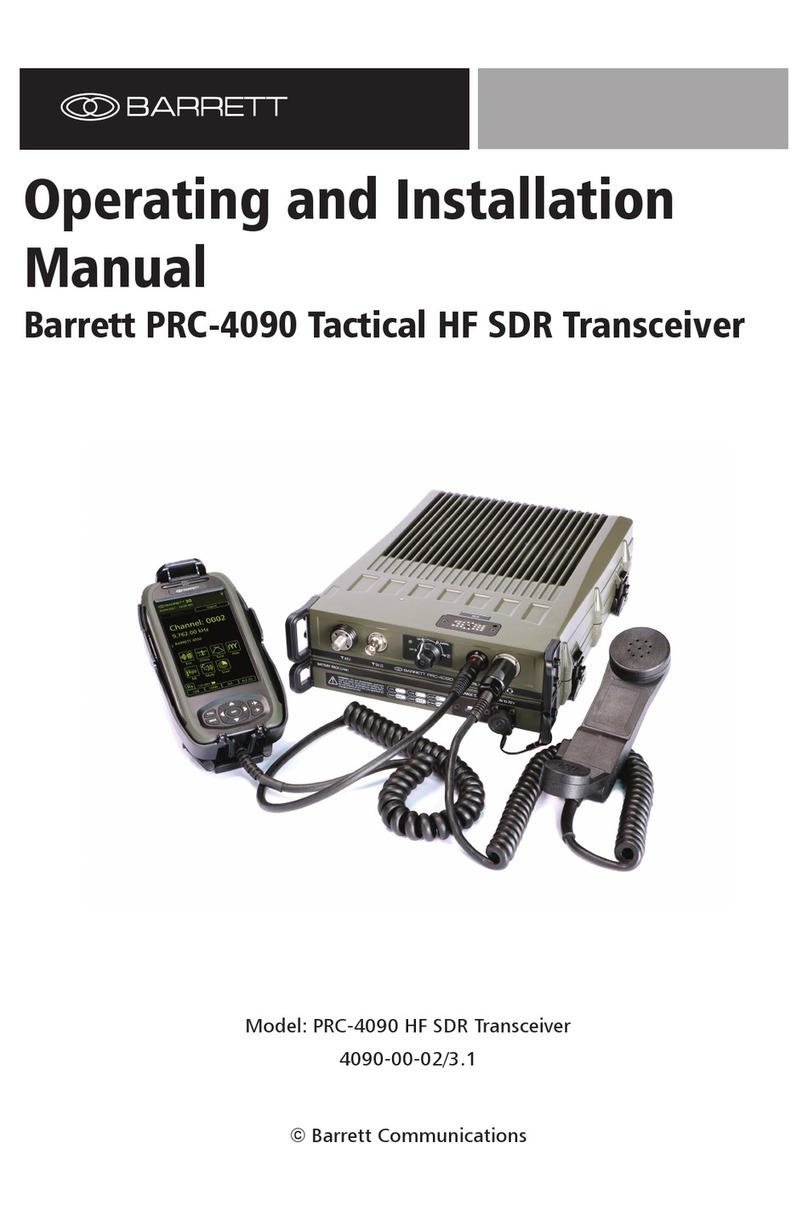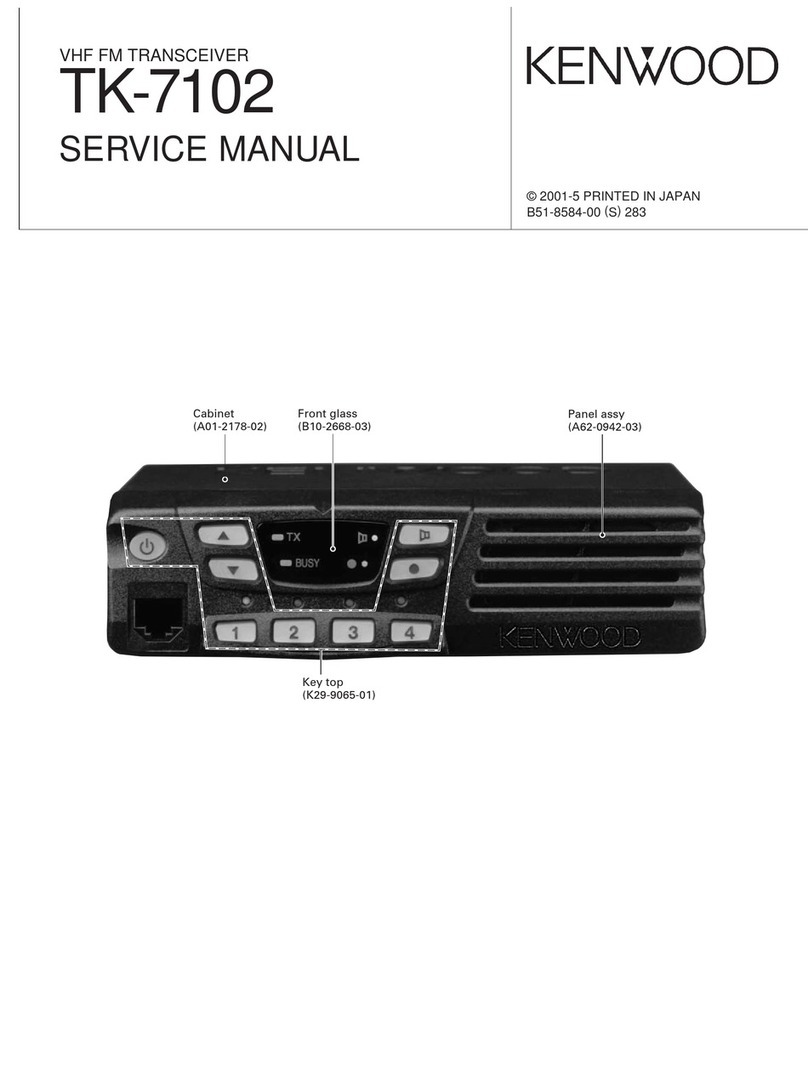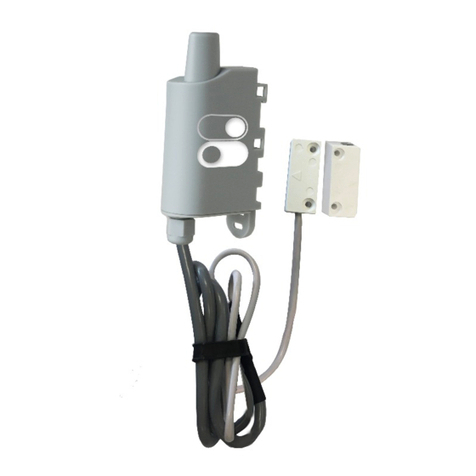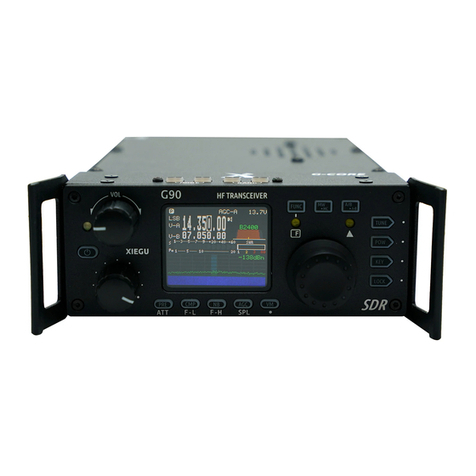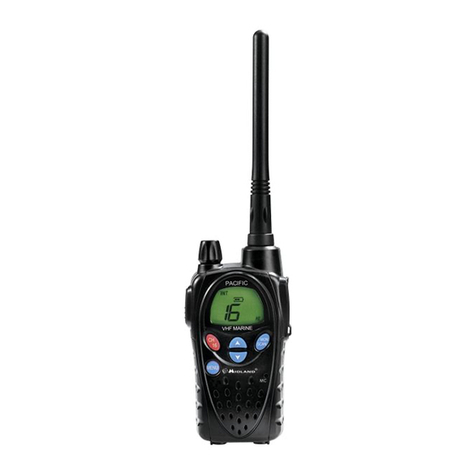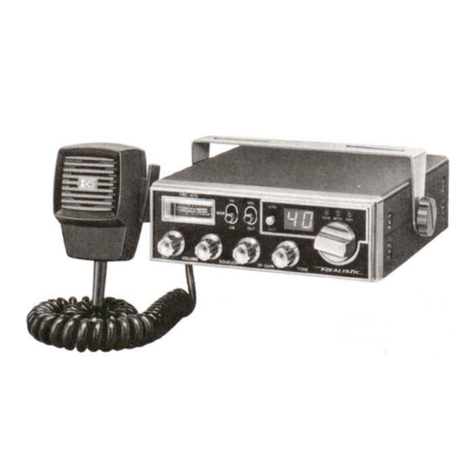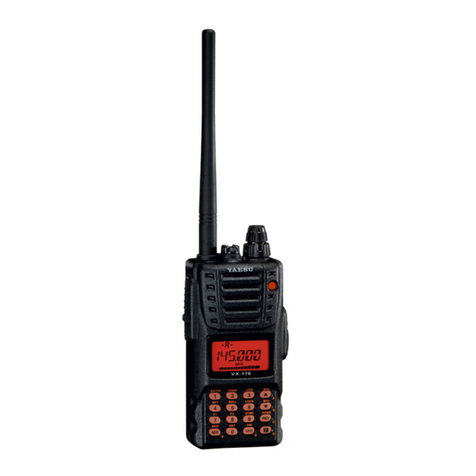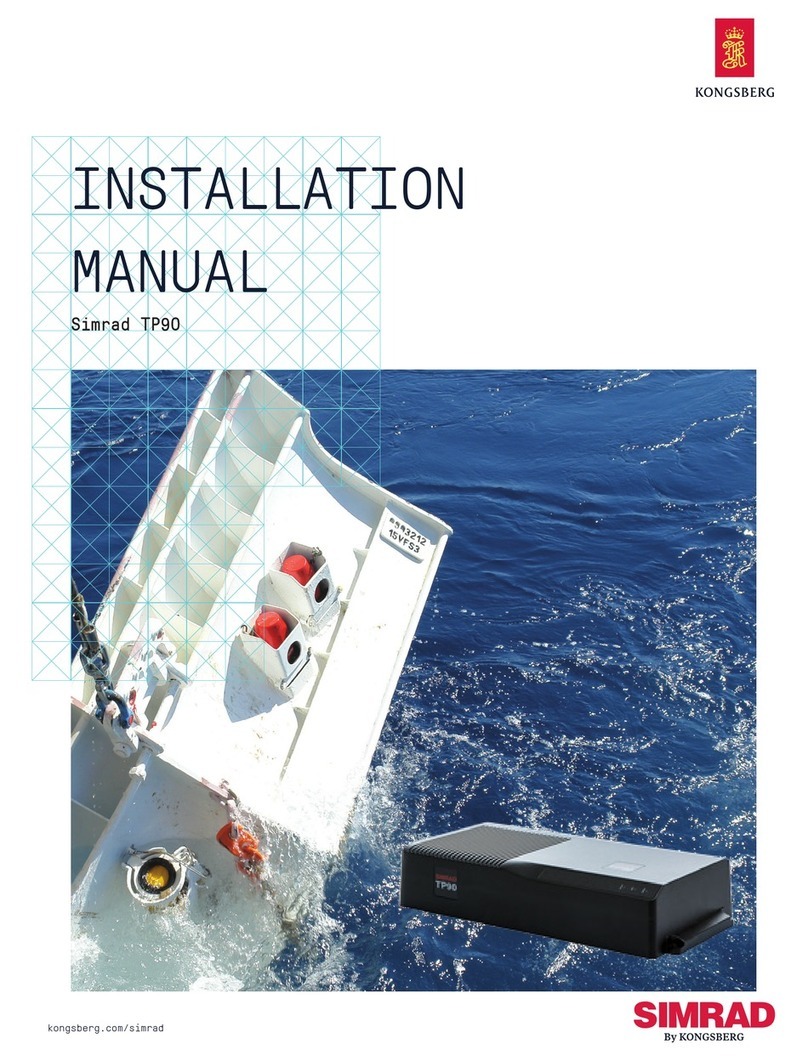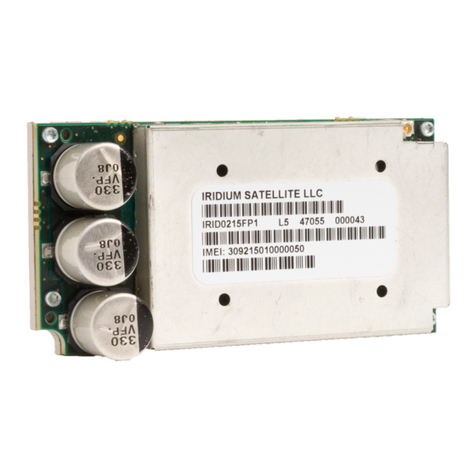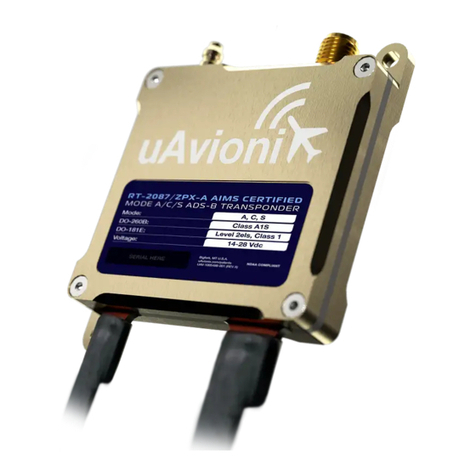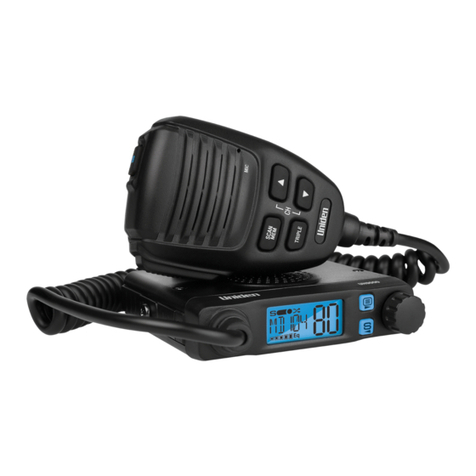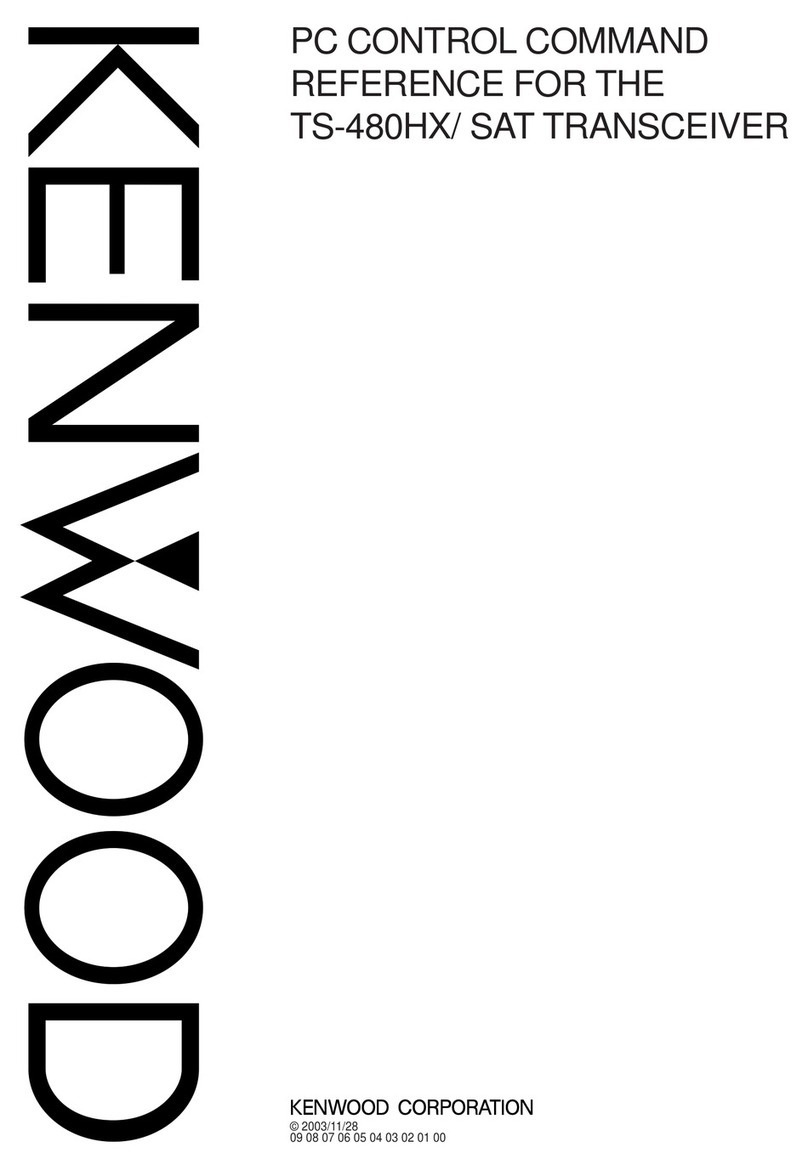Barrett 2050 Specification sheet

2 of 285
Barrett 2040,Barrett 2050 Compliance ......................................................................................... 8
FCC RF Exposure Compliance Statement .......................................................................... 8
FCC RF Exposure Warning .................................................................................................. 9
FCC Modulation Modes ........................................................................................................ 9
Industry Canada Modulation Modes .................................................................................... 9
About this Operating and Installation Manual .................................................................. 10
Icons and Standards ........................................................................................................... 10
Scroll Keys ............................................................................................................ 10
Abbreviations and Acronyms ................................................................................ 10
Introduction .................................................................................................................................. 12
Operation ...................................................................................................................................... 13
User Controls ....................................................................................................................... 13
2050 Transceiver Front Panel Description ............................................................ 13
Keypad .................................................................................................. 14
Locking and Unlocking the Keypad ....................................................... 16
2050 Transceiver Control Head Rear View ........................................................... 18
Microphone Socket ............................................................................... 18
Transceiver Socket ............................................................................... 18
2050 Transceiver Rear Panel Description ............................................................ 19
Switching on the Transceiver ............................................................................................ 20
Switching on the Transceiver – Without a PIN ...................................................... 20
Switching on the Transceiver – With a PIN ........................................................... 20
Switching Off the Transceiver ............................................................................... 20
Display .................................................................................................................................. 21
Receive Mode ....................................................................................................... 21
Transmit Mode ...................................................................................................... 21
Secure Mode ......................................................................................................... 22
Channel Attributes ................................................................................................. 22
Adjusting the Audio Volume .............................................................................................. 23
Selecting a Channel ............................................................................................................ 23
Using Channel Up/Down Keys .............................................................................. 23
Direct Channel Number Entry ............................................................................... 24
Using the Microphone ......................................................................................................... 25
Barrett Selective Calling System ....................................................................................... 26
General ................................................................................................................. 26
International .......................................................................................... 26
OEM 1 ................................................................................................... 26
CCIR ..................................................................................................... 26
ALE FED STD 188 / MIL STD 188-141B (option) ................................. 26
Selective Call –“Selcall” ........................................................................ 27
Selective Call “Telcall” .......................................................................... 27
Special Notes When Using OEM 1 Selective Call Protocol .................. 27
More Selective Calling Information ................................................................................... 28
Selcall Self IDs ...................................................................................................... 28
Selcall Decode ...................................................................................................... 28
Selcall Transmit ..................................................................................................... 28
Default Self IDs ..................................................................................................... 29
Setting Default Self IDs ......................................................................... 29
Detaching an ID from the Default Self IDs ............................................ 30
Contacting Another Station - Using Selective Call “Selcall” and Telcall ................ 32
Entering Station IDs and Using the Address and Telephone Books ..................... 32
When Asked to Enter a Station ID:- ...................................................... 32

3 of 285
Changing Self IDs During a Call ........................................................... 34
Station ID Ranges ................................................................................. 36
When Asked to Enter a Telephone Number:- ....................................... 37
Checking for the Best Channel to Use Between Two Stations - Beacon Call....... 38
Sending a Beacon Call ......................................................................... 38
Receiving a Beacon Call ....................................................................... 39
Sending a Selcall .................................................................................................. 39
Receiving a Selcall ................................................................................................ 40
Receiving a Selcall Directed to Your Transceiver ................................. 40
Receiving Allcalls, Group Calls and Sub-group Calls ........................... 41
Emergency Calls ................................................................................................... 43
Receiving an Emergency Call ............................................................... 45
Direct Dial Telephone Calls - Telcalls ................................................................... 46
Making a Direct Dial Telephone Call - Sending a Telcall ...................... 46
Last Number Redial .............................................................................. 47
Hang-up Call ......................................................................................... 48
Preset/Predialled (Abbreviated Number) Telephone Calls ................... 49
Fixed and Preset Address Book Entries ............................................... 51
Call History .......................................................................................................................... 53
Erasing Calls From History ................................................................................... 53
Scanning Channels ............................................................................................................. 55
Selcall Scan .......................................................................................................... 55
Signal Strength Scan (SSL Scan) ......................................................................... 55
Voice (Syllabic) Scan ............................................................................................ 55
Selecting a Scan Table ......................................................................................... 56
Initiating Scan ........................................................................................................ 56
Clarifier ................................................................................................................................. 57
Noise Reduction Selection ................................................................................................. 58
Mute (Squelch) Selection .................................................................................................... 59
Mode Selection .................................................................................................................... 60
Tune ...................................................................................................................................... 60
Advanced Selective Call Functions ................................................................................... 61
Requesting Another Station’s GPS position .......................................................... 61
Sending Your GPS Position to Another Station .................................................... 63
Text Messaging – “Pagecall”, “SMS” .................................................................... 65
Sending a “Pagecall” “SMS” ................................................................. 65
Receiving a “Pagecall” “SMS” ............................................................... 67
Special Characters in a Pagecall .......................................................... 68
Remote Station Operational Status – “Statcall” .................................................... 70
Requesting Another Station's Status .................................................... 70
Person to Person(s) Secure Call ........................................................................... 72
Tuning the Receiver ............................................................................................................ 73
Scanning with the Tunable Receiver ................................................................................. 74
Setting up Scan Frequencies ................................................................................ 74
Start Receiver Scanning Manually ........................................................................ 76
Menu Functions ........................................................................................................................... 77
Menus ................................................................................................................................... 77
Standard Menu .................................................................................................................... 78
Identification ........................................................................................................................ 78
Display Options ................................................................................................................... 80
Backlight Level ...................................................................................................... 80
Backlight Timeout .................................................................................................. 81
Call History .......................................................................................................................... 82
New Call ................................................................................................................ 82
Inbox ..................................................................................................................... 82

4 of 285
Outbox ................................................................................................................... 83
Address Books .................................................................................................................... 85
Selcall ID Book – Add a New Entry ....................................................................... 85
Selcall ID Book – Edit an Entry ............................................................................. 88
Selcall ID Book – Erase an Entry .......................................................................... 90
Phone Book - Add a New Entry ............................................................................ 92
Phone Book - Edit an Entry ................................................................................... 94
Phone Book - Erasing an Entry ............................................................................. 96
ALE Autofill Book .................................................................................................. 97
ALE Autofill Book – Reassign an Entry ................................................................. 98
ALE Autofill Book – Erase an Entry ..................................................................... 100
Audio Scrambler ................................................................................................................ 101
To Enable Scrambled Mode ................................................................................ 103
To Disable Scrambled Mode ............................................................................... 103
2040 Antenna Select (Available When 2050 Deployed in 2040 Manpack Adaptor) ..... 104
Protected Menu ................................................................................................................. 105
General ............................................................................................................................... 105
Microphone Up/Down keys ................................................................................. 105
Transmit “Over Beep” .......................................................................................... 106
Transmit Timeout ................................................................................................ 107
Channel Labels ................................................................................................... 108
Edit Labels .......................................................................................... 108
Delete a Label ..................................................................................... 109
Add an Entry ....................................................................................... 110
Setting the Clock ................................................................................................. 111
Setting the Date .................................................................................................. 112
B.I.T.E. Test ........................................................................................................ 113
Option Installation ............................................................................................... 114
Hopping PIN number entry .................................................................................. 115
Secure call code .................................................................................................. 116
Security Level ...................................................................................................... 117
Upload pack ........................................................................................................ 118
Internal Modem ................................................................................................... 119
Scan Tables ....................................................................................................................... 120
Adding Channels to a Scan Table ....................................................................... 120
Editing Channels in a Scan Table ....................................................................... 121
Erasing Entries in a Scan Table .......................................................................... 123
Changing Scan Table Labels .............................................................................. 124
Scan Settings ..................................................................................................................... 125
Scan Rate ........................................................................................................... 125
Scan Dwell .......................................................................................................... 126
Scan Resume Time ............................................................................................. 127
Scan Table Select ............................................................................................... 128
Mute Settings ..................................................................................................................... 129
Syllabic Mute Sensitivity ...................................................................................... 129
Signal Strength Mute Level ................................................................................. 130
Selcall Settings .................................................................................................................. 131
Self IDs ................................................................................................................ 131
Adding Self IDs ................................................................................... 131
Modifying Self IDs ............................................................................... 133
Deleting Self IDs ................................................................................. 135
Selcall INT 1 – Setting Default International Four Digit Selcall Self ID ............... 137
Selcall INT 2 – Setting Default International Six Digit Selcall Self ID .................. 137
Selcall OEM 1 – Setting Default OEM Four Digit Selcall Self ID ......................... 137
Selcall OEM 2 – Setting Default OEM Six Digit Selcall Self ID ........................... 138

5 of 285
Setting Selcall MMSI – GMDSS Selcall self ID (for future use) .......................... 138
Selcall Alarm ....................................................................................................... 139
Selcall Transmit Tones Audio Level .................................................................... 140
Selcall Pre-amble Length Setting ........................................................................ 141
TXCVR Lock ....................................................................................................... 142
OEM Privacy Key ................................................................................................ 144
Audio Settings ................................................................................................................... 145
Audio Bandwidth ................................................................................................. 145
“Beep” Volume Level ........................................................................................... 146
Receiver Audio Path Configuration ..................................................................... 147
Transmitter Audio Path Configuration ................................................................. 148
Line Audio ........................................................................................................... 149
Noise Reduction .................................................................................................. 150
RF Settings ........................................................................................................................ 151
Optional IF Filter Enable ..................................................................................... 151
Receiver Pre-amplifier ......................................................................................... 152
Clarifier Range .................................................................................................... 153
Noise Blanker ...................................................................................................... 154
RF Power Level ................................................................................................... 155
AGC Hang ........................................................................................................... 156
I/O Settings ........................................................................................................................ 157
RS-232 Out ......................................................................................................... 157
RS-232 Baud ....................................................................................................... 158
External Alarm ..................................................................................................... 159
Antenna Type ...................................................................................................... 160
GPS Receiver Enable ......................................................................................... 162
Line Output Level Adjust ..................................................................................... 163
Line Input Level Adjust ........................................................................................ 164
Frequency Hopping (Option - Export Permit Required) ........................................................ 165
Selecting the Hop Band ...................................................................................... 165
Entering the Security Code ................................................................................. 165
Security Codes and Bandwidths ......................................................... 165
To Enable Hopping Mode ................................................................................... 166
To Disable Hopping Mode ................................................................................... 166
Security Code Management ................................................................................ 167
Changing the Hop Code ..................................................................... 167
Code Distribution ................................................................................ 167
Network Planning and Contingencies ................................................. 167
Automatic Link Establishment (ALE) (Option) ....................................................................... 168
ALE System Overview ........................................................................................ 168
Operation Overview ............................................................................................ 168
To Commence Scanning ..................................................................................... 169
Linking to Another Station in an ALE Network .................................................... 170
Making a Netcall .................................................................................................. 173
Sending an ALE Text Message to Another Station in an ALE Network .............. 176
Making a Telephone Call via ALE Stations with Telephone Interconnect Facilities
............................................................................................................................ 181
Selecting ALE Station IDs ................................................................................... 185
Receiving an ALE Call ........................................................................................ 187
Receiving an ALE Message ................................................................................ 190
Receiving an ALE Telephone Call ...................................................................... 192
Receiving an ALE Netcall .................................................................................... 194
Closing Individual ALE links ................................................................................ 196
Closing all ALE Links .......................................................................................... 198

6 of 285
Remote Station Closes the ALE Link .................................................................. 199
Combined ALE / Selective Call Capability ...................................................................... 200
Overview ............................................................................................................. 200
To Commence Scanning ..................................................................................... 200
Transmitting an ALE Call .................................................................................... 201
Receiving an ALE Call ........................................................................................ 201
Receiving and Transmitting a Selective Call (Selcall) ......................................... 201
ALE Configuration Menus ................................................................................................ 202
ALE State ............................................................................................................ 202
ALE Autofill .......................................................................................................... 203
ALE Scan List ...................................................................................................... 204
Transmit Control .................................................................................................. 205
Response Control ............................................................................................... 206
Sounding Control ................................................................................................ 207
Sounding Address ............................................................................................... 208
Link Quality Analysis (LQA) Exchange ............................................................... 209
Link Quality Analysis (LQA) Exchange Mode ..................................................... 210
Link Quality Analysis (LQA) Averaging ............................................................... 211
Link Quality Analysis (LQA) Decay Rate ............................................................. 212
Threshold Test .................................................................................................... 213
SINAD Threshold ................................................................................................ 214
BER Threshold .................................................................................................... 215
ALE Fill Mode ...................................................................................................... 215
Programming Functions ...................................................................................... 216
Programming Using the Barrett 2050 Programming Software ............................ 216
Programming Using the Barrett Cable P/N BCA90023/BCA204020 .................. 216
Programming a Channel from the Front Panel ................................................... 217
Transmit and Receive Frequencies .................................................... 217
Channel Use Labels ............................................................................ 218
Operating Mode .................................................................................. 218
Transmitter Power Setting .................................................................. 219
Antenna Socket Selection ................................................................... 219
Selcall Format ..................................................................................... 220
Cloning (Programming) from Another Transceiver ............................................. 221
2050 Transceiver in the 2040 Manpack Adaptor ..................................................................... 223
Fitting the 2050 Into the 2040 Manpack Adaptor ................................................ 224
Removing the Battery Cartridge .......................................................................... 224
Powering and Charging the Barrett Manpack ..................................................... 225
Charging a 10Ah Lithium Ion Battery Cartridge Outside the Manpack ............... 226
Battery Charge Indicator when Charging the 2040 ............................................. 227
Operation in the Manpack Configuration ........................................................................ 228
Manpack Operation Using the Automatic Antenna Tuner ................................... 228
Using the Whip .................................................................................... 228
Using the Throw Over Long Wire Antenna ......................................... 229
Using the Counterpoise ...................................................................... 230
Operation of the Manpack in Frequency Hopping Mode ............................................... 231
Operation of the Manpack in Temporary Base Stations ................................................ 232
Deploying the End Fed Single Wire Low Power Broadband ............................... 232
Deploying the Tactical Rapid Deploy, Tuned, End Fed, Low Power Dipole ....... 233
Connectors ........................................................................................................................ 234
Auxiliary Socket ................................................................................................... 234
ESU/CW Socket .................................................................................................. 235
Handset Socket ................................................................................................... 235
Power Socket ...................................................................................................... 236

7 of 285
Installing the Barrett 2050 Transceiver ................................................................................... 237
Land Based Systems ........................................................................................................ 240
Mobile Installations ........................................................................................................... 253
Barrett 2019 Automatic Tuning Mobile HF Antenna ...................................................... 262
Mounting the Barrett 2019 Automatic Tuning Mobile HF Antenna ...................... 262
Antenna Assembly .............................................................................................. 264
Mounting the Base Spring ................................................................... 264
Mounting the Whip Sections ............................................................... 265
Testing the Barrett 2019 Automatic Tuning Mobile HF Antenna ......................... 266
910 Automatic Tuning Mobile Antenna ........................................................................... 267
Marine Installations ........................................................................................................... 274
Connectors ........................................................................................................................ 278
Overview of HF Operation ........................................................................................................ 280
Limited 3 Year Warranty ........................................................................................................... 284
Warranty Registration and Customer Support ............................................................... 285

8 of 285
Barrett 2040,Barrett 2050 Compliance
Barrett 2000 series transceivers comply to the following communications
standards:-
Australian / New Zealand Standard
MF and HF radio communications
Equipment in the land mobile service utilising single sideband suppressed carrier
emission
AS/NZS 4770:2000
FCC Part 90
Barrett 2000 series transceivers comply to the following EMC standard:-
EN301 489-1 V 1.4.1 (2002-08)
Barrett 2000 series transceivers comply to the following electrical safety
standard:-
EN60950-1:2002
FCC RF Exposure Compliance Statement
The Barrett 2040 Manpack Transceiver and the Barrett 2050 HF Transceiver have
been tested and comply with the Federal Communications Commission (FCC) RF
exposure limits for the General Population/Uncontrolled exposure environment.
In addition, it complies with the following Standards and Guidelines:
FCC 96-326, Guidelines for Evaluating the Environmental Effects of Radio-
Frequency Radiation
FCC OET Bulletin 65 Edition 01-01 (2001) Supplement C, Evaluating Compliance
with FCC
Guidelines for Human Exposure to Radio Frequency Electromagnetic Fields
ANSI/IEEE C95.1-1992, IEEE Standard for Safety Levels with Respect to Human
Exposure to Radio Frequency Electromagnetic Fields, 3 kHz to 300 GHz
ANSI/IEEE C95.3-1992, IEEE Recommended Practice for the Measurement of
Potentially Hazardous Electromagnetic Fields - RF and Microwave

9 of 285
FCC RF Exposure Warning
To ensure optimal transceiver performance and to avoid exposure to excessive
electromagnetic fields, the antenna system must be installed according to the
instructions provided.
High voltages exist on the antenna during transmission and tuning. Do not touch
the antenna during these activities. RF burns may result.
Install the grounding system or counterpoise as directed to prevent RF burns from
any metal part of the transceiver.
Safe working distance is based on continuous exposure to CW type transmissions,
as set out in the ICNIRP Exposure Guidelines (1998) for occupational exposure.
Safe working distance can be reduced with normal voice communication.
For FCC compliance, when the 2050 transceiver is used at a power level of
100 watts PEP, the antenna(s) used with this transceiver should be located at least
3 metres from the operator and should not be co-located or operating in conjunction
with any other antenna or transmitter.
For FCC compliance, when the 2040 transceiver is used at a power level of
30 watts PEP, the antenna(s) used with this transceiver should be located at least
1.5 metres from the operator and should not be co-located or operating in
conjunction with any other antenna or transmitter.
FCC Modulation Modes
Please note that J3E Upper Sideband Mode is the only modulation mode available
for operation in the United States of America.
Industry Canada Modulation Modes
Please note that J3E Upper Sideband Mode is the only modulation mode available
for operation in Canada.

10 of 285
About this Operating and Installation Manual
This manual is comprehensive, describing all aspects of the transceivers functions
and should be viewed as a reference manual.
A separate abbreviated Quick Reference Guide card with primary functions is also
supplied with each transceiver and should be kept at the operating position of the
transceiver.
Icons and Standards
Scroll Keys
This manual refers to Scroll keys these keys are:-
to scroll Up to scroll Left
to scroll Down to scroll Right
Abbreviations and Acronyms
This term… Means….
ALE Automatic Link Establishment
Call history A list containing details of the last thirty
calls you have received
Station ID The ID of the station being called (the
receiving station’s self ID)
GPS Global Positioning System
HF High Frequency
Identification Code The unique reference identification (ID)
of your transceiver (not serial number)
LCD Liquid Crystal Display
LSB Lower Sideband (Not available in FCC

11 of 285
USB Upper Sideband
PCB Printed Circuit Board
PIN Personal Identification Number
PSTN Public Switched Telephone Network
PTT button Press-to-talk button
RDD Radio Direct Dial
Receive only channel A channel that allows you to receive calls but
not transmit calls
Revertive signal An acknowledgement signal automatically
transmitted from a station receiving a Selcall
RF Radio Frequency
Rx Receive
Scan Table A list of channels used when scanning for
incoming calls
Selcall Selective Calls
Telcall Telephone calls via the Selective Call
protocol
Self ID The programmed address identification
number of your station. (Used by other
stations to call you).
SSB Single Sideband (a transmission format)
Transmit channel A channel that allows you to receive and
transmit calls
Tx Transmit

12 of 285
Introduction
The Barrett 2050 transceiver is a DSP based, 500 channel HF SSB transceiver with
a frequency range of 1.6 to 30 MHz. The Barrett 2050 is designed using the latest
technology enabling a physically small package with a full feature complement.
Designed to operate in the most arduous environments, as encountered in off road
vehicles, vessels and aircraft, the Barrett 2050 will provide many years of efficient
and trouble free service.
The Barrett 2050 supports features such as Selective Call (Selcall), direct dial
telephone connection to base stations fitted with telephone interconnect systems
(Telcall), GPS location, ALE (Automatic Link Establishment), frequency hopping,
data transmission and remote diagnostics. These features make the Barrett 2050
HF transceiver one of the most economical and versatile HF transceiver available
today.
The Barrett 2050 transceiver, has catered for the increased use of HF data
transmission for Internet email access and point to point data applications, by
providing a comprehensive data modem interface port, high speed transmit to
receive switching, a high stability frequency standard and an efficient cooling
system option.
The Barrett 2050 transceiver can be operated in either a local (desktop)
configuration for base station applications or, with the addition of an inexpensive
mobile pack, in a remote control (trunk mount) configuration for mobile applications.
When coupled with the 2040 manpack adaptor the 2050 becomes a full
specification military/civilian manpack.
Operating from 12 volt (13.8 V DC) DC supplies, the transmitter is rated at 125 watt
PEP in voice mode and is protected from over-voltage or reverse voltage
application.
All 500 channels are available to be field or workshop programmable. Auxiliary
features such as Selcall, Telcall, scanning, mute status, alarm system etc. can be
individually enabled or disabled for every channel as required to suit your operation.
Teamed with other matching Barrett 2000 series products which include antennas,
power supplies, vehicle tracking packages and HF modems, the Barrett 2050 HF
transceiver becomes a powerful tool, providing solutions to many long distance
communication requirements.

13 of 285
Operation
User Controls
2050 Transceiver Front Panel Description
LCD Screen
Keypad
Alert Button
The Alert button is used to send Emergency Selcalls or tone calls.
Power On/Off Button
The Barrett 2050 transceiver is turned on by pressing the green power button.
The transceiver is turned off by again pressing the green power button.

14 of 285
Keypad
There are 23 keys on the keypad. A group of five keys in the centre access many
major functions. Some keys have multiple functions assigned to them depending on
when the key is pressed and for how long the key is pressed. Key functions are
listed below followed by a detailed description of their functions.
Key
Key Primary function
Secondary function
Power on/off
None
Channel up
General scroll key
Channel down
General scroll key
Volume up
None
Volume down
None
Make a call
None
Enter
Lock / Unlock Keypad
Emergency call
None
Enter menus
None
Transmitter tune mode
Change case
HELP
Enter clarifier tune mode
Alpha “mno”
Numeric key “6"

15 of 285
Key
Key Primary function
Secondary function
Clear back one step
None
Enter direct channel change
mode
Decimal point
Enter tuning receiver
Mode
Alpha “ghi”
Numeric key “4"
Turn scrambler on / off
Alpha “tuv”
Numeric key ”8"
Enter program mode
None
Mute (squelch ) selection
Alpha “space”
Numeric key “0"
Mode select
USB, LSB, AM, CW, AFSK
Alpha “pqrs”
Numeric key “7"
Start scan, hold for 2
seconds for scan table
selection
Alpha “wxyz”
Numeric key “9"
Scroll left
Numeric key “1"
Scroll up
Alpha “abc”
Numeric key “2"
Scroll right
Alpha “def”
Numeric key “3"
Scroll down
Alpha “jkl”
Numeric key “5"

16 of 285
Locking and Unlocking the Keypad
The keypad can be locked by the user to stop accidental key press activity.
To lock the keypad press and hold down the key. The display will show
the following :
Once the key has been held down long enough the “Keypad Locked”
message will be displayed.
The “Keypad Locked” message will be shown whenever a key is pressed.
To unlock the keypad press and hold down the key. The display will
show the following :

17 of 285
Once the key has been held down long enough the “Keypad Unlocked”
message will be displayed./
The keypad will automatically unlock when a Selcall or ALE call is received.

18 of 285
2050 Transceiver Control Head Rear View
Microphone Socket
The microphone supplied with the Barrett 2050 is inserted here.
Note:- When the transceiver is supplied it is assembled in the one piece base
station configuration and the microphone is already fitted. If using the 2050 in the
remote control (trunk mount) configuration refer to the section “Installing the Barrett
2050 transceiver”.
Transceiver Socket
When used in a base station configuration (one piece unit, as supplied) the small
remote head interface cable supplied in the kit is plugged in here with the other end
into the front of the main transceiver module. When used in the remote control
(trunk mount) configuration the longer interface cable supplied is used.

19 of 285
2050 Transceiver Rear Panel Description
Input for GPS receiver Barrett P/N BCA20009 for vehicle tracking/location
applications.
Output for cooling fan unit Barrett P/N BCA20002 for high duty cycle
applications.
Interface for Barrett automatic tuning mobile antenna and marine automatic
antenna tuners.
Power input and speaker output for use with 2022 power supply.
Auxiliary antenna socket (channels can be programmed to use this socket or
the main antenna socket when using different antennas).
Main antenna socket.
Auxiliary interface connector.
Input for CW key Barrett P/N BCA20014.
Output for loudspeaker Barrett P/N BCA20015.
Chassis earth connection.
Serial number, Internal modem/ Scrambler fitted. (Appropriate box will be
marked if option fitted)

20 of 285
Switching on the Transceiver
Switching on the Transceiver – Without a PIN
Press for 1 second turns transceiver on.
Switching on the Transceiver – With a PIN
Press for 1 second turns transceiver on.
Enter the PIN number and press key
The transceiver will now be switched on, if however the incorrect
PIN number was entered the following is displayed:-
This display will time out and allow the re-entry of the PIN
number. If however the PIN number is entered 10 times
incorrectly the transceiver will not allow PIN number entry for a
period of one hour displaying the following:-
Note:- The power on PIN number would have been loaded into
the transceiver during programming if the function is in use. Refer
to your network administrator.
Switching Off the Transceiver
Press for 1 second turns transceiver off.
Other manuals for 2050
1
Table of contents
Other Barrett Transceiver manuals

Barrett
Barrett 2090 Specification sheet
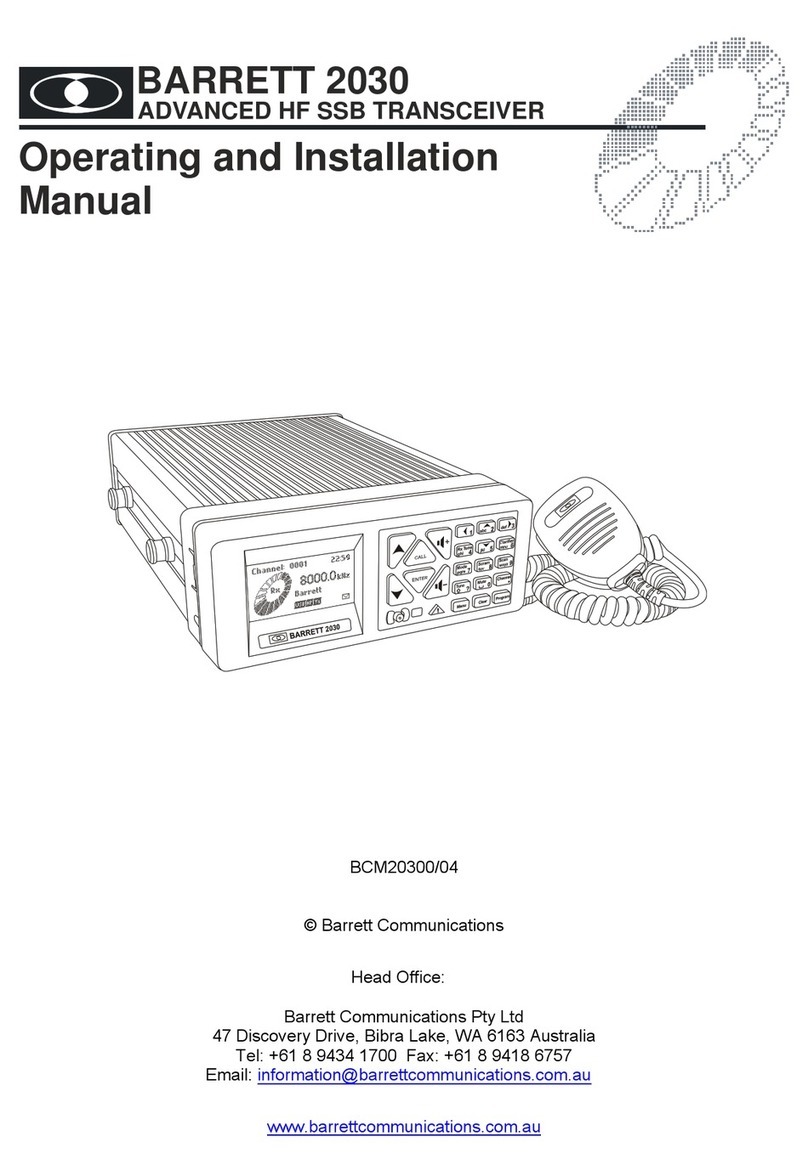
Barrett
Barrett 2030 Specification sheet

Barrett
Barrett 2000 Series User manual
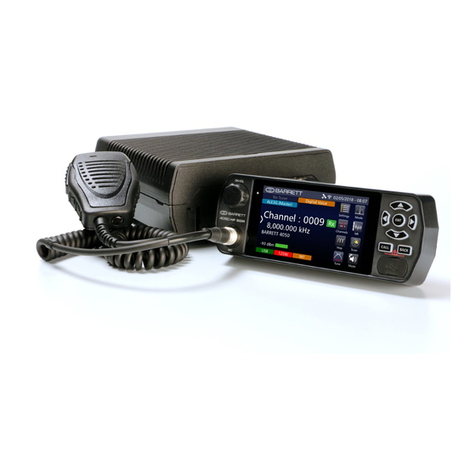
Barrett
Barrett 4050 HF SDR User manual

Barrett
Barrett 4050 HF SDR Specification sheet
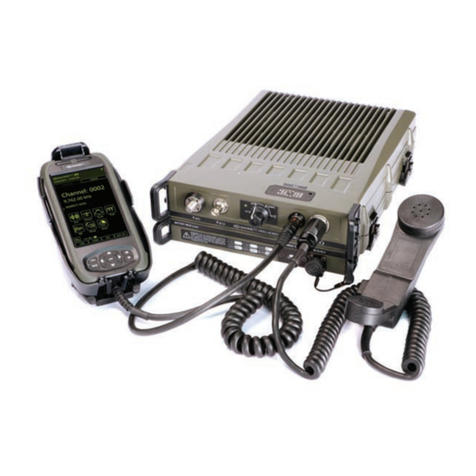
Barrett
Barrett PRC-4090 Specification sheet

Barrett
Barrett 4050 HF SDR Specification sheet
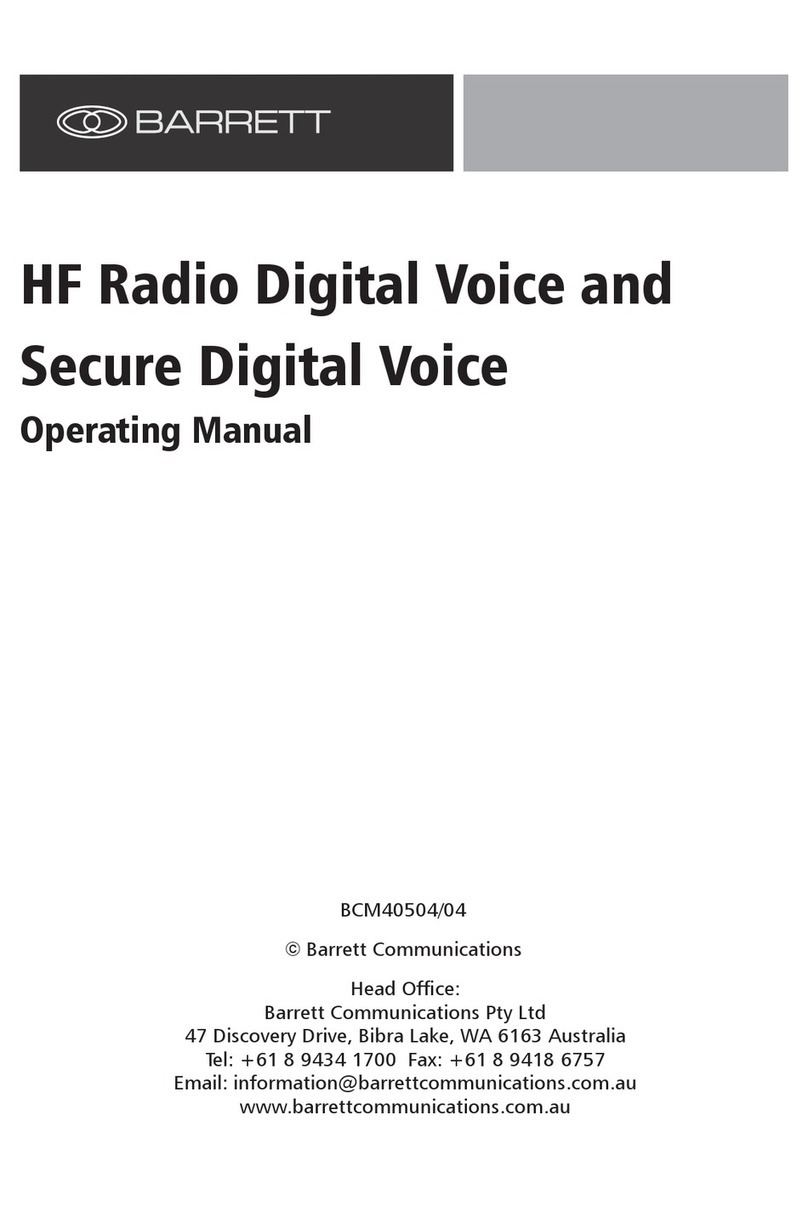
Barrett
Barrett 4050 HF SDR User manual

Barrett
Barrett 550 User manual
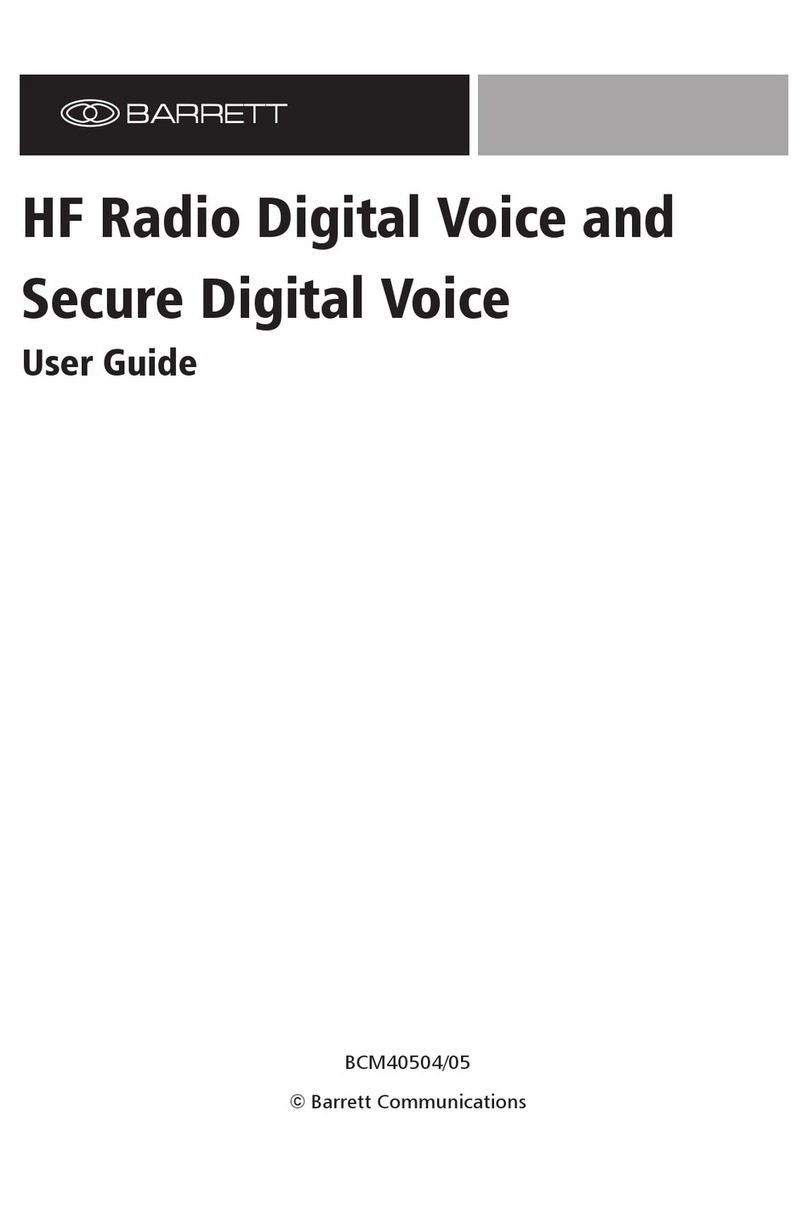
Barrett
Barrett HF SDR 4000 Series User manual

